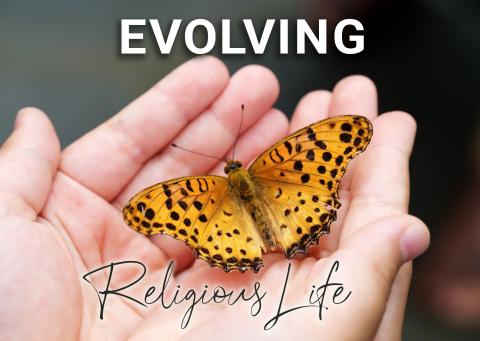
(Unsplash/Natalie Pedigo)
Editor's note: "Evolving Religious Life," a new series from Global Sisters Report, is exploring how Catholic sisters are adapting to the realities of congregations in transition and new forms of religious life. While we write often about these trends, this particular series will focus more closely on sisters' hopes for the future.

As we navigate the journey from an institutional stage to an interindividual stage of development, it would be wise for women religious to pay heed to the insights of Bob Dylan and Walt Whitman. This, in addition to turning to God, the communion of saints, and the support of each other, could provide a profound depth to the journey.
Human developmental psychologist Robert Kegan, in his book The Evolving Self, has noted that everyone on the planet is affected by this universal evolutionary movement. We do not really have a choice. We are already moving. We can only choose how we will move: what we will keep and what we will let go of.
Indeed, the late 20th and early 21st centuries have been both revolutionary and evolutionary. Our heated physical environment and its impact on all creatures is obvious. If planet Earth is to remain life-sustaining, we must change our attitudes and adopt radically new habits. Thus, an admonition by Dylan is worth pondering: "Life isn’t about finding yourself, or finding anything. Life is about creating yourself." But so is the proclamation of Whitman: "I celebrate myself, and sing myself."
Kegan tells us that evolving to the interindividual stage will be wholesome only if we welcome others into our "space," celebrate them as they "sing themselves," and collaborate with them to meet the evolving needs of all creatures.
To accomplish this exacting work, women religious will need to take good care of themselves as individuals and communities. They will need to be consummately collegial and inclusive.
Thankfully, they have the capacity to do this because they have collective wisdom gleaned from years of experience. In addition, they can rely more heavily on their feminine instinct than they were able to do during the institutional stage of individual and communal development.
To be successful, women religious will also need to nurture their creative, courageous spirits, which must begin by increasing their tolerance for contradictions, paradoxes and ambiguity. For the way they were formed and lived their everyday lives for decades was characterized by permanence, certainty and unquestioned acceptance. There might have been tension between what they longed for and what they could actually do, but they had grounds to believe they were accomplishing the will of God.
Advertisement
The 1962-65 Second Vatican Council opened the door to reimagining religious life based both on original charisms and contemporary realities. But at the same time institutional mindsets limited what could actually be changed. Furthermore, powerful backlashes on the part of select members of the church and society — including some women religious — undermined all but superficial change.
Nonetheless, women religious are still being called to evolve to the interindividual stage. It is a bidirectional phenomenon. It is "inter" in the sense of honoring and integrating all members of the human community. It is not exclusive. And it is "individual" in that it requires women religious to remain themselves and let others do the same.
The "good news" is that integrating these two directions will bring about a positive outcome. It will enable sisters to reach new levels of intimacy within themselves and with others.
Ambiguity will morph into certainty, for one thing will merge with its opposite, Notre Dame Sr. Melannie Svoboda assures us in When the Blue Heron Flies: Prayer-Poems to Nourish the Spirit:
Learn to live with ambiguity, with blurred lines, fuzzy edges,
fluid seams where one thing spills into its opposite.
Be patient with all that is uncertain in your life.
Enjoy mixtures, befriend apparent contradictions,
don't be in such a rush to get closure every time.
The "bad news" is that adopting a "both-and" attitude and way of meaning-making is psychologically challenging. It sounds good in principle, but putting it into practice requires one to be very flexible and tentative: willing to stay with contradiction, paradox, uncertainty and ambiguity until a consensus is reached.
Thus, women religious in general will have to develop new civil dialogue skills. They will have to change their hearts in order to undermine their tendency to be achievement-oriented and discouraged and/or resentful when "things take too long."
Kegan's advice should be helpful. Kegan recommends that one makes conscious efforts to be creative by being curious and playful. Reframing serious work as play will make one more comfortable with not knowing. It will lower anxiety when one is unable to pin down meaning until nearing the completion of the process in which one is engaged.
Kegan assures one that the best chance of eventually producing workable solutions depends heavily on acclimatizing to a sense of flow. Acknowledging continual change is more realistic than believing it will come to an end with a new solution.
From a psychological perspective, women religious will benefit from keeping in mind that moving through development stages is a given for human beings.
In fact, along with such prophetic writers as Jean Piaget, Erik Erikson, Abraham Maslow, Teilhard de Chardin, Carl Jung and Lawrence Kohlberg, Kegan says that in time we will have to resonate with yet another evolutionary movement. It will be a spiritual stage: a union of the human with the divine Other, God.
Indeed, from a psychological perspective, women religious will benefit from keeping in mind that moving through development stages is a given for human beings. "The fundamental ground of personality is evolutionary activity," Kegan writes.
Back to tasks women religious are called to perform at this time. They must cease to be achievers intent on doing. They must become "be-ings" who are interpersonally and intimately connected with each other. They must be intent on being themselves and giving others the same opportunity.
Furthermore, they are called to live with contradiction and paradox and embrace the tension between them. Rather than drive them out and force a communal resolution of problems, they must honor differences until they are truly oriented to them and nourished by them. For all persons are a unique icon of God. All are members of one human community. All are potential contributors to our understanding of the will and plan of the Creator.
Some practical examples of what women religious must work on:
- Reminding themselves that even evolutionary developmental movement involves, to some extent, the death of an old self for the sake of the birth of a new self, as Svoboda says.
- Keeping in mind that "all transitions involve leaving a consolidated self behind before any new self can take its place," in the words of Kegan.
- Taking better care of themselves psychologically and physically by expressing all emotions appropriately as close to when they experience them as possible.
- Finding bodily ways to express emotions because "nature intended all emotions to lead to immediate physical activity," as Dr. Helen Flanders Dunbar explained. Considering dancing to express select emotions.
- Replacing winning over others with designing win-win solutions with them.
- Resolving issues by collaborating with all concerned rather than doing so by themselves or with select others.
- Lengthening the time they devote to information gathering before they draw conclusions by engaging in brainstorming.
- Increasing comfort with the tension inherent in paradox and contradiction by being curious. For example, they might ask those they find difficult to love how they might better do so.
- Deepening their tolerance for ambiguity by listening to others with openness.
- Being more creative in designing solutions.
- Making solutions tentative, if possible, by setting times and/or occasions for reevaluating them. For every shift in evolutionary growth, Kegan says, "involves the relativizing of what was taken as ultimate" and consciously choosing to do so.
- Weakening their proclivity to judge and condemn by coming up with more than one or two hypotheses for why they and others hold opinions and act a certain way. Then systematically testing those hypotheses.
- Standing against condemning judgment, as Kegan advises, by saying to others such things as "I can't judge you as evil or wrong." Similarly, standing against affirming judgment by saying something like "I can't affirm what you are doing."







